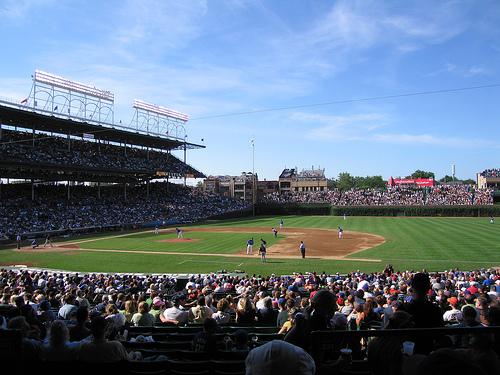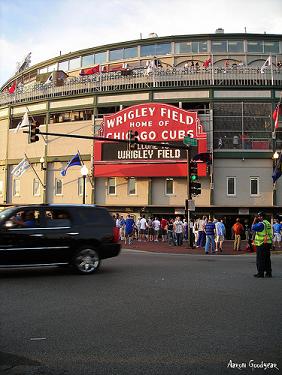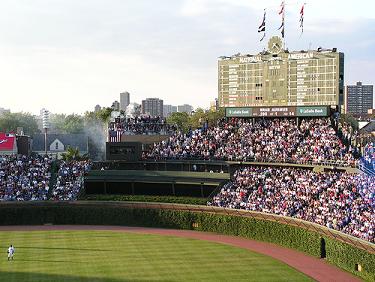|
Wrigley Field, Home of the Chicago Cubs
 Ballpark Overview
Ballpark Overview
Historic Wrigley Field, located in Chicago, Illinois, has been the home ballpark of the Chicago Cubs since 1916. Former names of the Cubs' home include Weeghman Park from 1914 to 1920 and Cubs Park from 1920 to 1926. 
Weeghman Park, built in 1914, was the home of the Chicago Whales, a Federal League baseball club. Cubs Park was the last name of the ballpark until former owner and chewing gum mogul William Wrigley, Jr. renamed it Wrigley Field in 1926. From 1921 until 1970, it was the home for another Chicago-based sports team, the National Football League's Chicago Bears. Wrigley is located in Lakeview on West and South Addison Street, East Sheffield Avenue and North Waveland Avenue. "Wrigleyville" is the area surrounding the ballpark that hosts restaurants, bars, and other businesses. Ernie Banks, a hall of fame Chicago Cubs shortstop, nicknamed Wrigley Field "the Friendly Confines." As of 2011, the current seating capacity is 41,160, which ranks Wrigley 10th in the MLB smallest ballpark category. Not only is Wrigley the last Federal League park still standing, it is the oldest ballpark in the National League, and the second oldest ballpark in Major League Baseball. The Friendly Confines is highly recognizable for the unusual wind patterns off Lake Michigan, its legendary red marquee over the main entrance, ivy covered brick outfield wall, and its hand turned scoreboard. Ballpark Quick Facts
Ballpark History The Chicago Cubs named its home park after its owner, William Wrigley, Jr., the chief executive officer of Wrigley Company. Prior to naming the ballpark Wrigley in the roaring 20's, two elves posing as a batter and a pitcher known as the Doublemint Twins sat above the scoreboard. After the team replaced the bleachers in 1923, the Doublemint Twins were the only visible in-park advertising. In 1937, the Cubs removed the elves.  In 1914, the Chicago Whales built Weeghman Park (now Wrigley) in approximately 6 weeks at a cost of $250,000. If you adjust the original construction costs for inflation, if built today, the stadium would cost over $5 million.
In 1914, the Chicago Whales built Weeghman Park (now Wrigley) in approximately 6 weeks at a cost of $250,000. If you adjust the original construction costs for inflation, if built today, the stadium would cost over $5 million.
Charles Weeghman, former owner of the Chicago Whales, funded the construction of Weeghman Park (now Wrigley). The Chicago Whales signed a 55-year lease to rent the ballpark for $18,000 annually. Weeghman Park was designed by the architect of Comiskey Park, Zachary Taylor Davis The seating capacity of Weeghman Park is unclear since one source says it was 14,000 and another puts it at 20,000. The Federal League folded by the end of 1915. With no team to play at Weeghman Park, Charles Weeghman formed a group, which included William Wrigley, Jr., to purchase the Chicago Cubs for $500,000 from then owner Charles P. Taft. In 1918, William Wrigley, Jr. acquired controlling interest in the Cubs and then, 8 years later in November 1926, renamed the ballpark after himself. Renovations of Wrigley began in 1927 with the addition of an upper deck. In 1937, Bill Veeck, son of Chicago Cubs president, decided to plant ivy vines alongside the outfield walls. Although Wrigley Field has been the home of the Cubs since 1916, it has yet to see the Cubs win a World Series. The Cubs have come close with several appearances in the World Series (1923, 1929, 1932, 1936, 1938, and 1945). The Cubs last won the World Series in 1908 while playing at West Side Park.
|
Grab Your Copy of the FREE Baseball Betting Guide And NEVER Struggle Betting on Baseball Again!

